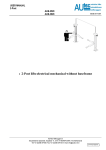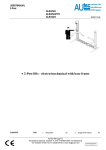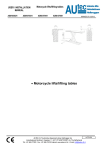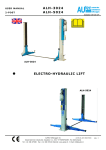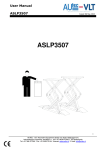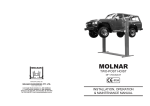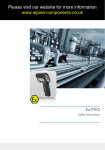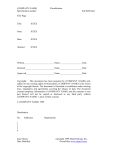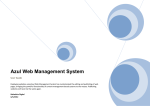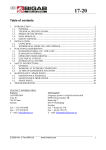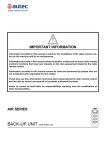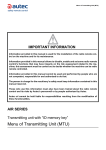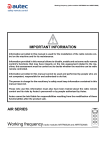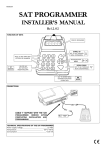Download en-TA-APT 1
Transcript
USER MANUAL 2-Column APT-3000 / APT-3500 APT-5000 ISSUED 04-02-2004 • 2-Column vertical lifts AUTEC Hefbruggen bv Industrieterrein Ijsselveld, Vlasakker 11, 3417 XT MONTFOORT, The Netherlands Tel:+31 348 477000 Fax:+31 348 475104 E-mail: [email protected] en/TA-APT-3500-01 USER MANUAL 2-Column APT-3000 / APT-3500 APT-5000 INDEX OF CONTENTS 1 Introduction 2 How to use this Manual 3 Description of the lift 4 Technical specifications 5 Safety 6 Controls and operation 7 Maintenance 8 Troubleshooting 9 Conformity Declaration PAGE 02 02 02 03 03 05 07 07 08 1. INTRODUCTION ability to explain the drawings and the descriptions contained in this manual to other people. At the same time he must also be aware of the general and specific safety regulations which apply in the country where the lift is being installed. The word “operator”, which has been used throughout this manual, refers to a person who is authorised to use the platform. The minimum legal age for using the lift is 18 years. ISSUED 04-02-2004 CONTROL CABINET (Fig. 2) The electrical control cabinet consists of the following : • Main switch (11) • Lifting motion button (12) • Lowering motion button (13) 3. DESCRIPTION OF THE LIFT CAUTION This Manual is intended for factory personnel who are going to operate the lift; read the Manual before you use the platform in any way or perform any actions on it. This Manual contains important information about the following points : n THE PERSONAL SAFETY OF THE OPERATORS n THE SAFETY OF THE LIFT n THE SAFETY OF THE VEHICLES LIFTED 2. INSTRUCTIONS FOR USE The Manual forms part of the lift and must be available for reference in the immediate vicinity of the lift at all times. The operator of the lift must be able to refer to the Manual quickly and at any given moment. 2 column electro-hydraulic column vertical lift, models APT 3000, APT3500, APT-5000. These platforms are embedded in the floor of the workspace and are designed and manufactured for lifting passenger cars and delivery vans and to maintain them in this lifted position. The main components of the lift are : • A steel case • Hydraulic cylinders • Electro-hydraulic pumping unit • Safety arrangements • Control cabinet • Support chassis In Fig. 1 you can see how the various parts come together to form a lift. SAFETY ARRANGEMENTS n Non-return valves in the valve block which are operated electrically. When the voltage is cut-off, these valves close automatically and prevent the lift from sinking back to the original position. n Overpressure valve n Arm locking mechanisms on the support arms. n Hydraulic non-return valves which limit the speed of the lowering motion in the case of hose rupture. IT IS STRONGLY RECOMMENDED THAT YOU SHOULD FIRST CAREFULLY READ THE SAFETY INSTRUCTIONS. The manufacturer hereby refuses to accept any responsibility for injury to persons or damage to equipment or property if it appears that incorrect handling of the lift has taken place. This instructions manual only describes the operating- and safety aspects which persons who are installing the machine need to know. In order to understand the terminology used in this manual, it is necessary that the person performing the installation work should have specific experience in industrial work, service, maintenance and repair activities, and must also possess the Fig. 2 n The torsion beam prevents the support plate and the sliding tracks from getting displaced or distorted. In addition, if any of the cylinders fail, these torsion bars transfer the power to the cylinder which is still working properly. Fig. 1 n Electrical protection through fusible cut-outs. AUTEC Hefbruggen bv Industrieterrein Ijsselveld, Vlasakker 11, 3417 XT MONTFOORT, The Netherlands Tel:+31 348 477000 Fax:+31 348 475104 E-mail: [email protected] en/TA-APT-3500-02 USER MANUAL 2-Column APT-3000 / APT-3500 APT-5000 4. Technical specifications APT 3000/P Max. Load capacity Max. Speed of lifting in cm/sec Max. Speed of lowering in cm/sec Operating pressure in bar Pressure limitation in bar Operating voltage in Volt Control voltage of the valve in Volt Control voltage for the electronic components in Volt Noise level in dB(A) Limit switch for height limitation Limit switch for downward movement signalling Pneumatic emergency lowering valve Working environment Motor power in Kw Voltage in Volt Frequency in Hz Connected load APT 3500/R APT 3500/R1 APT 3500 R/WF APT 3500 R1/WF1 APT 3500/K APT 3500/P ISSUED 04-02-2004 APT 3500/V APT 3500/VL APT 5000/R1/WF1 APT 5000/V APT 5000/R APT 5000/R1 3000 Kg 6,5 7,0 160 180 400 196 24 3500 Kg 6,5 7,0 180 200 400 196 24 5000 Kg 4,5 5,0 180 200 400 196 24 70 Yes No 70 Yes Yes 70 Yes Yes No Covered Yes Covered Yes Covered 3 400 50 400V / 16A 3 400 50 400V / 16A 3 400 50 400V / 16A WEIGHT AND SIZE OF THE VEHICLE The lift can be used for practically all vehicles provided that the maximum loading capacity at the support points is not exceeded. Always take into account the lifting capacity of the lift in the case of large vehicles with special characteristics (such as delivery vans, etc.). The safety zone (Fig. 3) is determined by the dimensions of the vehicle. MAX.3000 kg APT 3000 MAX.3500 kg APT 3500 MAX.5000 kg APT 5000 5. SAFETY It is important to read point number 5 of this Manual properly since it contains important information about the risks which the operator of the lift will be exposed to if the lift is not used properly. In what follows, you will find information about how to avoid dangerous situations. WARNING. The lift is designed and constructed to lift vehicles and to hold them in a certain position in a covered working place. Any other form of use is not permitted. In short, the lift is not suitable for the following purposes : n Washing and spraying work. n To be used as a device for applying force. n To be used as a goods lift. n To be used as a jack or for lifting vehicles for changing wheels. The manufacturer hereby refuses to entertain any claims for damages arising in connection with injury to persons or damage to vehicle or other property caused due to incorrect and/or unauthorised use of the lift. During lifting- and lowering movements, the operator must be within the zone of operation (1), as shown in Fig. 3. The presence of any person in the danger zone (2) is strictly forbidden. The presence of persons under the vehicle is only permitted if the vehicle is parked in the lifted position. USE THE LIFT ONLY IF ALL THE SAFETY ARRANGEMENTS ARE WORKING PROPERLY. IF THESE RULES ARE NOT FOLLOWED, SERIOUS INJURY COULD BE CAUSED TO PERSONS AS WELL AS IRREPARABLE DAMAGE TO THE LIFT AND THE VEHICLE ON THE LIFT. GENERAL PRECAUTIONS • The operator is bound to follow the regulations which apply in the country in which these lifts are installed. In addition, the operator must : • • • Always work in the operator area as designated in the manual. Never remove the protective guards or dismantle or shut down the mechanical, electrical or other types of safety arrangements or locks. Read the safety regulations relating to the lift and take cognisance of the safety information provided in this Manual. The following terms have been used in this Manual to describe the various types of risk : Fig. 3 RISK : this indicates a potential danger which could lead to serious injury or death. AUTEC Hefbruggen bv Industrieterrein Ijsselveld, Vlasakker 11, 3417 XT MONTFOORT, The Netherlands Tel:+31 348 477000 Fax:+31 348 475104 E-mail: [email protected] en/TA-APT-3500-03 USER MANUAL 2-Column APT-3000 / APT-3500 APT-5000 RISKS TO PERSONS This paragraph describes the risks to which the operator or any other person near the working area where the lift is in operation, in case the lift is not used in the appropriate manner. WARNING: this indicates situations and/or actions which are unsafe and could lead to injuries of various types except death. RISKS AND PROTECTIVE MEDIA The risks to which the operator is exposed when the vehicle is in a raised position, together with the protective media which have been installed, in order to limit the possible dangers. LONGITUDINAL AND LATERAL MOVEMENTS OF THE VEHICLE. Longitudinal and lateral movements include the following : forward- and backward movements of the load (the vehicle). Lateral movements include displacement of the vehicle to the left or the right, particularly during the lifting process. These movements can be prevented by positioning the vehicle on the lift in the correct manner. CAUTION Do not try to move the vehicle when it is on the lift. The support part of the lift should only be shifted when it is in the lowest position and there is no load. It is extremely important that the vehicle is placed on the lift in such a manner that there is an uniform distribution of weight over the arms (Fig. 4). Try to place the centre of gravity of the load as far as possible in the centre of the lift. For the maximum distribution of weight, see the table shown below and the drawing as well. MAX. WEIGHT DISTRIBUTION APT-3000 3 : 1800 Kg 2 1200 Kg APT-3500 2 : 2333 Kg 1 1167 Kg APT-5000 2 3333 Kg : 1 1667 Kg ISSUED 04-02-2004 Fig. 4 To ensure the safety of persons and of materials, you must see to it that : • The safety zone is kept under observation during the lifting process. • The motor of the vehicle is switched off. • The vehicle must be lifted on the car-jack support points as indicated by the manufacturer. • The support points of the vehicle, and the lift must both be free of oil and grease. • Due account has been taken of all the dimensions and weights. RISKS INVOLVED IN LIFTING A VEHICLE The following safety arrangements have been installed in order to prevent damage due to overloading and faults : SAFETY ARRANGEMENTS n Non-return valves in the valve block which are operated electrically. When the voltage is cut-off, these valves close automatically and prevent the lift from sinking back to the original position. RISKS TO PERSONNEL When the lift with the vehicle is moving downward, it is not permissible for any of the personnel to enter the room or walk under the (downward) moving parts of the lift (Fig. 5). The operator should not start the motion of the lift until he has assured himself that there are no persons within the danger zone. Fig. 5 DANGER ARISING DUE TO COLLISIONS This danger arises in connection with the parts of the car or other vehicle which are at head-height. If the lift is still at a lower level, the personnel must take care to see that they do not bump into parts of the vehicle, the lift or other parts, which are not marked with special warning colours. (Fig. 6). n Overpressure valve n Arm locking mechanisms on the support arms. n Hydraulic non-return valves which limit the speed of the lowering motion in the case of hose rupture. n Electrical protection through fusible cut-outs and a motor protection switch. Fig. 6 RISKS INVOLVED IN MOVING A VEHICLE Movements may be caused during activities which involve the application of an adequate amount of force for moving the vehicle (Fig. 7). In cases where the vehicle being lifted is almost of the maximum permissible weight or the maximum permissible dimensions, movements in the vehicle could lead to overloading or unbalancing. AUTEC Hefbruggen bv Industrieterrein Ijsselveld, Vlasakker 11, 3417 XT MONTFOORT, The Netherlands Tel:+31 348 477000 Fax:+31 348 475104 E-mail: [email protected] en/TA-APT-3500-04 USER MANUAL 2-Column APT-3000 / APT-3500 APT-5000 ISSUED 04-02-2004 RISKS ARISING DUE TO DEFECTIVE COMPONENTS DURING USE Autec uses material of the highest quality in its lift. The use of these must be made according to the standards, and maintenance must be done regularly. Fig. 7 RISKS INVOLVED IN POSITIONING A VEHICLE This type of risk may arise if the vehicle is not properly placed on the support points (Fig. 8), or if the support arms platforms are not properly aligned with respect to the lift. One can avoid this by always lifting the vehicle using the carjack support points as recommended by the manufacturer, and which are normally used for supporting car-jacks while changing tyres, and to place the vehicle as far as possible in the middle of the platform. 6. CONTROLS / OPERATION Fig. 10 Fig. 13 Fig. 11 Fig. 8 Never rest any fittings or other objects against the columns and never place such objects under the platform when it has a load mounted on it, since this can impede the lowering operations and may cause the vehicle to fall off the platform (Fig. 9). RISK OF ELECTROCUTION Never spray water or steam or solvents or paint in the area immediately surrounding the platform and the control cabinet (Fig. 12). Fig. 12 Fig. 9 Never enter the vehicle or start the motor when the vehicle is on the lift (Fig. 10). The control cabinet consists of : RISK OF SLIDING OUT This risk can be overcome by avoiding the spillage of oil or grease in the area surrounding the lift (Fig. 11). RISKS ARISING DUE TO INSUFFICIENT LIGHTING The area surrounding the lift must be well-lighted according to the legal requirements applicable in the region or country where the platform is installed. Fig. 14 MAIN SWITCH (11) Position 0 : In this position, the lift is no longer live, and one may now open the control cabinet. If necessary, a lock may be placed on the main switch, so as to prevent unauthorised access or operation of the lift. Position 1 : When the main switch (11) is in the position “1”, one cannot open the control cabinet. LIFTING MOTION BUTTON (12) This is a counter-sunk button which must be kept pressed down during the lifting process. (also called the 'dead man's button'). LOWERING MOTION BUTTON (13) This is a counter-sunk button which must be kept pressed down during the lowering process. (also called the 'dead man's button'). WHEEL-FREE SYSTEM (14 Fig. 14) In order to use the wheel-free system, the WF button (14) must be pressed simultaneously with the lifting motion button (12), during the lifting process. During the lowering motion, the AUTEC Hefbruggen bv Industrieterrein Ijsselveld, Vlasakker 11, 3417 XT MONTFOORT, The Netherlands Tel:+31 348 477000 Fax:+31 348 475104 E-mail: [email protected] en/TA-APT-3500-05 USER MANUAL 2-Column APT-3000 / APT-3500 APT-5000 downward motion button (13) and the WF button (14) must be pressed simultaneously. SEQUENCE OF OPERATIONS AND POINTS OF IMPORTANCE • The support points with which the vehicles are to be lifted are the same as the ones normally used for applying conventional car-jacks. In case of doubt, as to the location of the car-jack support points, please get back to your car manufacturer or dealer. • Before the car is positioned on the lift, one should ensure that the lift is in its lowest position. • Sudden acceleration or application of the brakes while the car is on the support plates is not permissible. • In the case of low-slung (with the chassis very close to the ground), that no direct contact is made with the lift. • Take care to see that the support points are free of oil or grease. • In the case of wheel-free systems, check that the car is positioned properly. • During the lifting and lowering operations, it is not permissible that persons are present in the danger zone. • SUPPORT POINTS APT-3500 / R / WF APT-3500 / R1 / WF1 APT-5000 / R1 / WF1 Push the vehicle onto the support plates. Now position the vehicle in the centre of the plates for sliding cars onto and down from the lift. A thumb rule which applies is that the front wheel comes to rest about 30 cm in front of the wheel-less lifting plates. The wheelfree lifting plates can be pushed out length-wise, on both sides. Push out the plates until they are under the car-jack support points recommended by the manufacturer. Then use the rubber support blocks supplied along with the lift, for lifting the vehicle. APT-3500 / R APT-3500 / R1 APT-5000 / R APT-5000 / R1 Push the vehicle onto the support plates. Now position the vehicle in the middle of the sliding plates. APT-3000 / P APT-3500 / P Push the support plates out upto the desired length. Move the vehicle in the correct direction over the support plates. Now position the rubber supports under the car-jack support points of the vehicle as specified by the manufacturer. In case of doubt regarding these car-jack support points, consult the dealer or the manufacturer of the vehicle. APT-3500 V APT-3500 / VL APT-5000 V Place the support arms along the length of the support wheels. In other words, place the support arms along the sliding direction. The slide-through area is now at its maximum. Slide the vehicle between the arms. Position the vehicle such that the distance between the front- and the rear wheels is more or less the same with respect to the centre of the lift. Position the rubber supports of the support arm under the car-jack support points specified by the manufacturer. APT 3500 / K Push in the support arm to the shortest length possible. Now position the ISSUED 04-02-2004 vehicle in the centre of the lift. Push the support arms over the support beams until they are in line with the car-jack support points. With the left hand, release the support arm locks. With the right hand pull out the arm until the support arm rubber comes to rest exactly below the car-jack support point specified by the manufacturer. • LIFTING Turn the main switch into position 1, and press the lifting motion button. Release the lifting motion button after the vehicle has been lifted above the ground level, and check whether the vehicle is safely positioned on the lift. If the vehicle is safely positioned, press the lifting motion button until the desired height is reached. • PARKING Release the lifting button when the desired height is reached, and then turn the main switch to the 0 position. • LOWERING First check whether there are any obstacles under the lift, turn the main switch in the position 1, press the lowering motion button, in order to lower the vehicle down to the desired height, or down to the ground. In case of lowering to ground level, the lift will be stopped when it reaches a height of about 120 mm above the ground, and an acoustic signal is given. The signal warns the user that he should first ensure that the danger zone is completely free of obstacles. When the lowering motion button is pressed again, the lift will be lowered further, accompanied by a continuous acoustic signal. EMERGENCY LOWERING OF THE PLATFORM If the powers gets interrupted, it is possible to lower the bridge, in the following manner : remove the centre plate. Hold the air hose and roll it out. Supply the air hose with compressed air. Before doing this, take care to see that the safety zone is free of persons and/or objects. Some types have a hole in the side of the control cabinet. Now supply the hole with compressed air. AUTEC Hefbruggen bv Industrieterrein Ijsselveld, Vlasakker 11, 3417 XT MONTFOORT, The Netherlands Tel:+31 348 477000 Fax:+31 348 475104 E-mail: [email protected] en/TA-APT-3500-06 USER MANUAL 2-Column APT-3000 / APT-3500 APT-5000 ISSUED 04-02-2004 7. MAINTENANCE The lift must be inspected once a year according to the CE Regulations, by a person who is certified to do the same. In addition, preventive maintenance must also be carried out once a year on the lift (ask for AUTEC maintenance contracts). We recommend the following lubricants for lubricating the lift : No. Texaco Shell ESSO Castrol 1. Hinged joints in the arm Molytex EP32 Alvania HDX-2 MS3 2. Lubricating nipples in the guides 3. Hydraulic system Molytex EP32 Alvania HDX-2 Rando 32 Tellus 32 Multipurpose + moly Multipurpose + moly Nutto H32 No. 1. 2. 3. Lubricating points Hinged joints in the support arms, if any + arm locks, if any Lubricating nipples in the column guides Replacement of hydraulic oil MS3 HYSPIN HWS 32 Lubricating interval 3 Months 1 year 5 years Search for the source of the fault, and carry out the necessary repairs only after all the necessary SAFETY REGULATIONS as described have been taken into account. i ALL “RESETTING” ACTIONS, REPAIRS TO THE SAFETY ARRANGEMENTS AND ELECTRICAL COMPONENTS IN THE LIFT MUST BE CARRIED OUT BY AUTHORISED PERSONNEL ONLY. PROBLEMS POSSIBLE CAUSES ? The lift does not move upward when the lifting button is pressed (motor is not running) ? The platform does not rise when the lifting motion button is pressed (the motor is running) ? The lift rises only partially ? The lift comes down on its own ? ? ? REMEDIAL ACTION The lift does not come down although the lowering motion button has been pressed ? ? ? ? ? ? ? ? ? • • ? ? ? ? ? • • The fuse has burnt out No power Fault in the electrical system Insufficient oil ?he hydraulic hose has ruptured The relief valve has opened ?he overpressure valve is in operation Leakage in the hydraulic circuit Seal is not sealing properly The thermal protection keeps tripping The lifting bridge is overloaded Voltage too low Insufficient oil Leakage in the airing valve Relief valve is choked up Relief valve is defective Foreign object under the lifting table Fault in the electrical system ? ? ? ? ? ? ? ? ? • • ? ? ? ? ? ? ? Replace the fuse Reconnect Call up the Autec service department Fill in oil Replace the hose Check/replace Check the weight on the lift Ring up AUTEC Ring up AUTEC Re-set the thermal protection Maintain the weight according to the specifications Check the voltage Fill in oil Ring up AUTEC Clean the valve Ring up AUTEC Remove the foreign object Ring up Autec service department The pump makes a noise Oil leakage in the cylinder ? ? Oil is contaminated The seal is damaged ? ? Replace the oil Ring up AUTEC DETAILS REQUIRED WHILE CALLING AUTEC SERVICE. If you are reporting a fault, try to provide at least the following data : n The serial number, the type and the year of manufacture of the lift. AUTEC Hefbruggen bv Industrieterrein Ijsselveld, Vlasakker 11, 3417 XT MONTFOORT, The Netherlands Tel:+31 348 477000 Fax:+31 348 475104 E-mail: [email protected] en/TA-APT-3500-07 USER MANUAL 2-Column APT-3000 / APT-3500 APT-5000 ISSUED 27-01-2004 9. CONFORMITY DECLARATION AUTEC Hefbruggen b.v. Waardsedijk Oost 8b NL 3417 ZK Montfoort The Netherlands declares hereby that the following lifts : APT-3000/P have been manufactured in accordance with the provisions contained in the RWTUV GUIDELINES and that the lift conforms to the said Guidelines, and have obtained the CE Certificate : 04 205-1342/98 after being subjected to inspection and testing. And also that : APT 3500/R APT 3500/R1 APT 3500 R/WF APT 3500 R1/WF1 APT 3500/K APT 3500/P APT 3500/V APT 3500/VL have been manufactured in accordance with the provisions contained in the RWTUV GUIDELINES and that the lift conforms to the said Guidelines, and have obtained the CE Certificate : 04 205-0577/98 after being subjected to inspection and testing. And also that APT 5000/V APT 5000/R1/WF1 APT 5000/V APT 5000/R APT 5000/R1 have been manufactured in accordance with the provisions contained in the RWTUV GUIDELINES and that the lift conforms to the said Guidelines, and have obtained the CE Certificate : 04 205-1343/98 after being subjected to inspection and testing. RWTUV Langemarckstrasse 20 D-45141 Essen Postfach 1032 61 D-45032 Essen Telephone +49 / 201 8 25-0 AUTEC Hefbruggen bv Industrieterrein Ijsselveld, Vlasakker 11, 3417 XT MONTFOORT, The Netherlands Tel:+31 348 477000 Fax:+31 348 475104 E-mail: [email protected] en/TA-APT-3500-08










